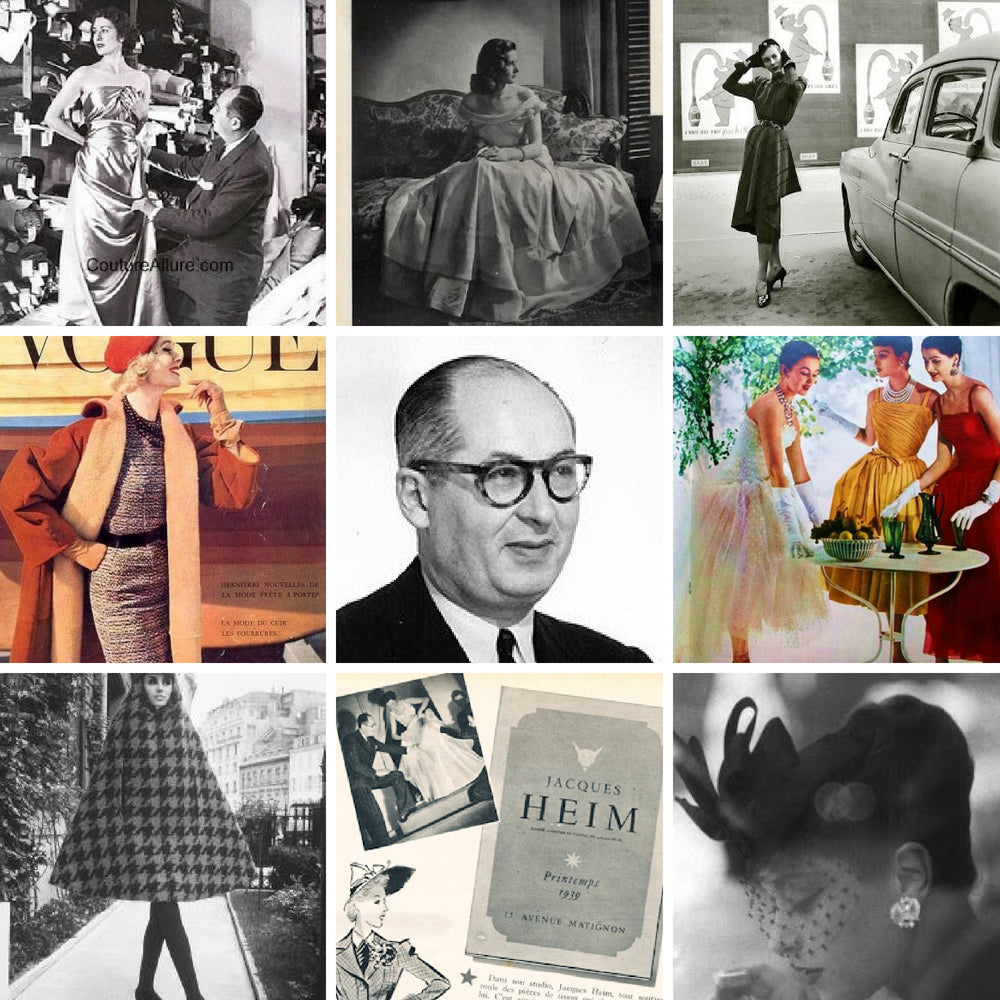🔥15% OFF- CODE GET 15 🔥
🔥15% OFF- CODE GET 15 🔥

Who Was Jacques Heim ?
February 20, 2020 4 min read
In the early 1920s, Jacques Heim started working in his parents' fur business, which they had founded in 1898. He took over the business in 1923, and within a few years had added a couture department, designing dresses and coats, made with original fabrics, working in collaboration with Sonia Delaunay. In 1930, the workshop became the fashion house, Jacques Heim.
He also made ready-to-wear and in 1936 started a line for younger women, Heim Jeunes Filles. In 1932, Heim created what we know today as "The Bikini". Check the next blog for its story.


He was harassed during the Nazi occupation of France but managed to stay in business by putting a non-Jewish "front man" in charge of his fashion house. He was an active member of the French resistance.
In 1946, Heim started a chain of sportswear boutiques.
Under the presidency of Charles de Gaulle, he was appointed designer of the president's wife, Yvonne de Gaulle. His most prominent clients were Sophia Loren, Queen Fabiola of Belgium, Mamie Eisenhower and actress Gloria Swanson.


In 1956, Heim made the bikini an international sensation when Brigitte Bardot wore one of his designs.
His fragrances included Alambie,1947, J'Aime,1958, Shendoah,1966, inspired by 'J'Adore from Dior.

Heim served as President de la Chambre Syndicale de la Haute Couture Francaise (Paris Fashion Trade Association) from 1958 to 1962.
Caroline Rennolds Milbank called Jacques Heim an "innovator by nature," in her 1985 book, Couture: The Great Designers.
Few would agree. Heim's New York Times obituary read: "Heim was basically an innovator in business. He didn't want to be called a designer, but rather an editor of clothes." He aggressively conceived of ways in which couture might be vital to new audiences (his "Heim Jeunes Filles" brought garments to a young audience long before other couture designers, and engendered early client loyalty) and was an impeccable spokesman for the fashion industry of France during the period of change between Haute Couture and Ready To Wear.
He was an editor of many design ideas, beginning with the possibilities of fur, continuing through the beach and play outfits, even the two-piece swimsuit, and the plane and planar simplifications of design in the youth-conscious 1960s.
If he was not driven by the market, he was at least keenly sensitive to it. Heim was a smart, eclectic designer of many styles; through consistent sales sensitivity, he transformed the fur business of his parents, Isadore and Jeanne Heim, founded in 1898, and persevered and prospered as a designer for nearly four decades.

Heim's fashion breakthrough was to realise that fur could be worked as a fabric. Wool and fur combinations, geometries of fur and textiles, and fur accents became hallmarks of the Heim fashion in the 1930s. At the same time, along with Chanel and Patou and others, Heim was alert to the possibilities of elegant sportswear and observed bathing and sports costumes as inspiration.

According to Milbank, Heim was inspired by the Tahitian exhibits in the Paris colonial exhibition of 1931 to create pareos and sarongs. Later, his 1950 two-piece swimsuit, Atome, addressed a broader public.
Through the 1950s, Heim addressed American needs for sportswear in innovative and utilitarian fabrics while still remaining, in the vocabulary of the day, very ladylike. Moreover, his Heim Actualité diffusion line, launched in 1950, extended his influence into Ready-To-Wear along with the young styles of Heim Jeunes Filles.
From 1958 to 1962, he was President of the Chambre Syndicale de la Haute Couture Parisienne, and was "probably the last most effective President of the couture's professional body," according to Women's Wear Daily.


Heim was steadfastly modern and business-oriented.
Favoured by Mrs Charles de Gaulle and a designer for Mrs Dwight D. Eisenhower, Heim understood the expression "old soldiers never die." He never married a style or became one form's advocate; instead, he had insisted on the business principle that fashion would thrive in change and adaptation.
"The life of a couturier is a magnificent and continuous torture," Heim said. But he was probably only expressing a businessman's shrewd romanticism and a leader's quixotic belief in fashion's anguish. His commerce was clearly his passion and his métier, making designs with acumen as well as inspiration.
—Richard Martin
After the success of the fragrance Allambie in 1947, Jacques Heim created and produced some well-known and today considered top perfumes like J'Aime (1958) and Shandoah (1966). The J'Aime perfume was the inspiration for the famous Christian Dior J'Adore.
The reason why Jacques Heim Couture House did not continue and sadly had to close its doors was due to the development, too late, of the Jacques Heim perfume and cosmetics. Effectively, it is the perfume and cosmetic industry that carries the haute couture houses, as only a very small percentage of the population is able to actually buy the haute couture dresses.
User Contributions:
Articles
Peterson, Patricia, "Heim Drops Hemline and Ban on Photographs," in the New York Times,23 July 1962.
Books
Milbank, Caroline Rennolds, Couture: The Great Designers, NewYork, 1985.
Steinmeyer, Anne, Who's Who in Fashion, Third Edition, New York,1996.
Pictures:
1st line top left: Jacques Heim working on a model
1st line middle: Jacques Heim Evening Dress 1946
1st line, right picture: Jacques Heim Dress photographed by Willy Maywald
2nd line 1st left picture from Vogue
2nd line middle picture of Jacques Heim
2nd line 3rd right picture: The new-look signature by Christian Dior, Jacques Fath & Jacques Heim
3rd line 1st picture: New in the 1950s
3rd line, right picture: The New Look top model Dorian Leigh posing with the fragrance J'Aime.
Leave a comment
Comments will be approved before showing up.

